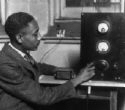Rufus P. Turner facts for kids
Quick facts for kids
Rufus P. Turner
|
|
|---|---|

Turner working on an early radio
|
|
| Born | December 25, 1907 Houston, Texas
|
| Died | March 25, 1982 (aged 74) |
| Education | Armstrong Tech California State College (BA, 1958) University of Southern California (MA, 1960; PhD, 1966) |
| Known for | Transistor radios; popular and technical electronics texts |
Rufus Paul Turner (born December 25, 1907 – died March 25, 1982) was a very smart person who worked as an engineer and a writer. He wrote many books and articles about electronics, like how tiny parts called semiconductors work. He also wrote about how to write technical stuff clearly.
For 30 years, he worked with electronic devices. He even helped create the first useful transistor radio. Later in life, at age 52, he went back to school and earned a special degree in literature. After that, he became an English professor! During his long career, which lasted for 60 years, he wrote more than 40 books and 3000 articles.
Contents
Early Life and Radio Inventions
Rufus Turner was born in 1907 in Houston, Texas. He started working with electronic parts called crystal diodes when he was just 15 years old. By age 17, he had already published his first article about radio electronics.
He went to a school called Armstrong Tech in Washington, D.C. In 1925, when he was still a teenager, he built the smallest radio set in the world at that time. He also got the second commercial radio operator's license in his area. His radio station, W3LF, was the first one licensed to a Black broadcaster in the U.S. By 1928, his station was quite powerful. He even operated a radio station for his neighborhood church.

Becoming an Engineer and Teacher
Even though he didn't go to college right away, Rufus Turner's skills in electronics led him to many engineering jobs. He was a licensed professional engineer in both California and Massachusetts. He also taught electronics at a special school and at the University of Rhode Island. Later, he taught business communication at the University of Southern California.
Pioneering Transistor Radios
In the 1940s, Turner helped create an important electronic part called the 1N34A germanium diode at a company called Sylvania. After transistors were invented in 1947, he quickly started experimenting with them.
In 1949, before transistors were even sold in stores, he wrote a popular article called "Build a Transistor." This article was very important for people who liked to build their own radios. In January 1950, after transistors became available, he published another article. It was called "A Crystal Receiver with Transistor Amplifier" and included plans for a radio that used three transistors.
These plans were printed four years before the Regency TR-1, which was the first commercial transistor radio. Turner's plans were the first time many radio fans learned about how useful transistors could be for building radios. He kept making his small, pocket-sized radios even better as new transistors came out. In 1956, he published a very popular article called "Transistor Portable with a Punch" in Popular Electronics. This article showed how to build an advanced four-transistor radio.
Writing About Electronics
For over 60 years, Rufus Turner wrote many articles and technical books about electronics. These books were for both people who liked electronics as a hobby and for professionals. While many early books about semiconductors focused on how they worked, Turner's books showed how to actually use them.
His work on semiconductors included helpful guides for parts like integrated circuits, solar cells, zener diodes, varactors, thermistors, varistors, and field-effect transistors. He also wrote about how to write technical information clearly, how to test electronics, and how to use oscilloscopes. He even wrote a basic math textbook.
Later Life and Literature
Even though he was mostly known for electronics, Rufus Turner had many different interests. In the mid-1950s, he decided to study literature. He earned his first college degree from California State College in Los Angeles in 1958. Then, he got a master's degree in English from the University of Southern California in 1960.
In 1960, he was hired as an English professor at California State College. In 1966, he earned his highest degree, a PhD, from U.S.C. His special project for this degree was about the life and writings of Charlotte Turner Smith, an old English writer. Turner taught at California State College until 1973. Even after he stopped teaching, he continued to publish articles about electronics. He passed away in March 1982.


